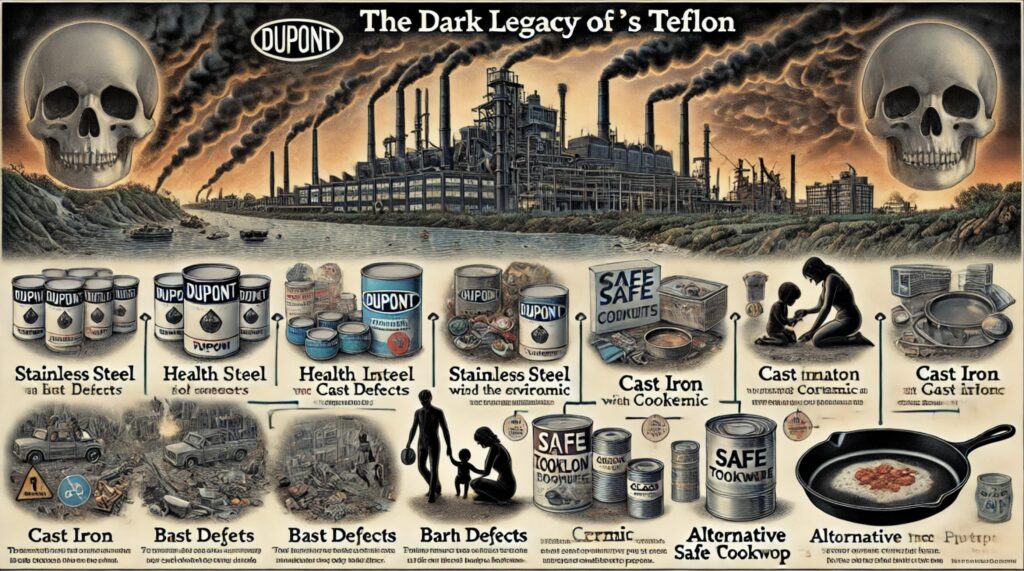The Hidden Dangers of Teflon: DuPont’s Dark Legacy and How to Protect Yourself
Teflon, the revolutionary non-stick coating, has a troubling history involving corporate deception, environmental contamination, and severe health risks. This blog post delves into the story of DuPont, the company that invented Teflon, the associated health hazards, and how to mitigate the risks.
The Invention of Teflon and DuPont’s Knowledge
Teflon, a brand name for polytetrafluoroethylene (PTFE), was invented by Dr. Roy Plunkett in 1938 while working for DuPont. Initially celebrated for its non-stick properties, Teflon quickly became a household staple. However, it was later revealed that DuPont was aware of the health risks associated with the chemical used in Teflon production, particularly perfluorooctanoic acid (PFOA), also known as C8.
The Health Risks of PFOA
PFOA is a “forever chemical,” meaning it does not break down in the environment and can accumulate in the human body over time. Exposure to PFOA has been linked to a range of serious health issues, including:
• Cancer: Studies have shown an increased risk of kidney, testicular, and other cancers in individuals exposed to PFOA  . • Birth Defects: Pregnant women exposed to PFOA have given birth to babies with birth defects, including facial deformities and developmental delays . • Liver Damage: PFOA exposure can lead to liver damage and altered liver function . • Immune System Effects: PFOA can affect the immune system, reducing the body’s ability to fight infections . • Endocrine Disruption: PFOA has been shown to disrupt hormone function, leading to various health problems .

Environmental Contamination
PFOA has been detected in the blood of 99% of Americans, a testament to its pervasive nature. It contaminates water supplies, as highlighted in numerous lawsuits and environmental studies. The chemical has been found in rivers, lakes, and even rainwater, affecting both wildlife and humans .
The Human Toll
The human cost of PFOA exposure is staggering. Communities near DuPont plants have reported higher incidences of cancer, autoimmune diseases, and birth defects. Workers at these plants have also suffered significantly, with many developing serious health issues. Lawsuits have revealed that DuPont knew about these risks but chose to conceal them to protect their profits  .
Safer Alternatives to Teflon
Given the risks associated with Teflon, it is wise to consider safer alternatives for cookware and other products. Here are some options:
1. Stainless Steel Cookware: Durable and non-reactive, stainless steel is a safe alternative. 2. Cast Iron Cookware: When properly seasoned, cast iron offers a naturally non-stick surface and adds iron to your diet. 3. Ceramic Cookware: Free from harmful chemicals, ceramic cookware provides a safe non-stick option. 4. Glass Cookware: Ideal for baking, glass cookware does not release any harmful substances. 5. Silicone Bakeware: Safe for baking and easy to clean, silicone is a non-toxic option.
Detoxing from Teflon Exposure
While no specific detox can eliminate PFOA, supporting your body’s natural detoxification processes is beneficial:
1. Stay Hydrated: Drinking plenty of water helps flush out toxins. 2. Eat a Clean Diet: Focus on organic fruits and vegetables, whole grains, and lean proteins to support liver and kidney function. 3. Exercise Regularly: Physical activity boosts circulation and aids detoxification. 4. Supplement Wisely: Consider supplements like activated charcoal, chlorella, and milk thistle to support detoxification. 5. Sauna Therapy: Regular sauna sessions can help eliminate toxins through sweat.
Getting Rid of Teflon
To reduce exposure to PFOA, consider the following steps:
1. Stop Using Teflon Cookware: Replace it with safer alternatives mentioned above. 2. Proper Disposal: Follow local guidelines for disposing of hazardous household waste. 3. Avoid Teflon-Coated Products: Be cautious of products like irons, hair straighteners, and fabric protectors that may contain Teflon.
Scientific Support
Research supports the transition to safer alternatives. Avoiding chemicals like PFOA and choosing non-toxic materials can significantly reduce the risk of health issues. Proactively switching to natural and safe cookware and household items is a step towards better health and a cleaner environment  .
Conclusion
The story of Teflon and DuPont is a cautionary tale about corporate negligence and the long-term impacts of chemical exposure. By understanding the risks and making informed choices, we can protect our health and reduce the environmental burden of these “forever chemicals.”
Further Reading and Evidence-Based Data
• Environmental Working Group on PFAS
• The Devil We Know Documentary
• Union of Concerned Scientists on PFAS Risks
• EPA on PFAS Chemicals
By staying informed and proactive, we can mitigate the risks associated with Teflon and create a healthier future for ourselves and the environment.
Go to my exclusive health group on Telegram
Discover more from
Subscribe to get the latest posts sent to your email.
